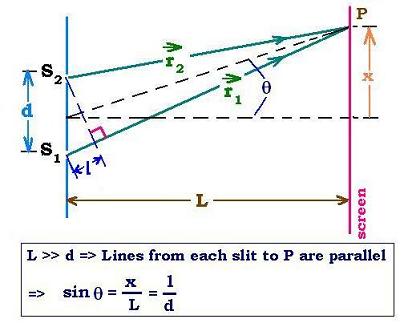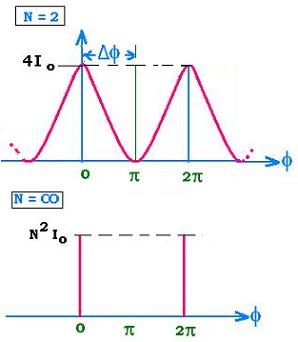A sigle wave
Superposition of waves
© The scientific sentence. 2010
|
Young's double-slit Interference
1. Interference fringes

Simple-slit experiment explains diffraction phenomenun, whereas
double-slit explains dinterference phenomenun.
Two light rays pass through two slits, separated by a distance d and reach a screen at a
distance, L from the slits.
As L >> d, we can consider that the lignes from the two slits to
the point P are parallel; so r2 - r1 = l = d sinθ = d x/L.
When the two rays pass through the two slits, the condition for constructive interference
is that = nλ, where n is an integral number and λ is the wavelength of the
ray (wave).
Constructive interference: d sinθ = nλ
Destructive interference: d sinθ = (n + 1/2)λ
On the screen, the bright bands correspond to the points of constructive interference,
and the dark bands correspond to the points of destructive interference. Both constite
waht we call interference fringes.
From x = L sinθ = L d sinθ/d , we have:
xbright = n L λ/d for the bright bands, and
xdark = (n + 1/2) L λ/d for the dark bands.
The bright bands are spaced by the distance:
Δx = xnext-bright - xbright =
[(n + 1) L λ - n L λ]/d = L λ/d
2. Intensity distribution
For each point "P" of the screen, the intensity I of light is calculated using the
principle of superposition. It is expressed as:
I = S = (1/2) εo E122, where E12
is the vectorial sum of the two electric field E1 and E2 of the rays
comming from the slit S1 and S2.
If E1 = Eo sin(ωt), and
E2 = Eo sin(ωt +φ), are the electric fiels
of each slit, then
E12 = Eo [sin(ωt) + sin(ωt +φ)].
sin(a + b) = sin a cos b + cos a sin b
sin (a - b) = sin a cos b - cos a sin b
By addition, we have sin (a + b) + sin (a - b) = 2 sin s cos b
with a + b = ωt + φ and a - b = ω t, that is a = ωt + φ/2 and b = φ/2
we obtain sin(ωt) + sin(ωt +φ) = 2 sin(ωt + φ/2) cos (φ/2)
E12 = 2 Eo cos (φ/2) sin(ωt+ φ/2), that oscillates with the amplitude
2 Eo cos (φ/2),
E122 = 4 Eo2 cos2 (φ/2) sin2(ωt + φ/2)
If Io is the intensity of light for a single slit, that is
Io = constant x Eo2, we have also
I12 = constant x Eo2
= Io x 4 cos2 (φ/2)
I12 = 4 Io cos2 (φ/2)
With
φ/2 π = d sin θ/λ, we have:
I12 = 4 Io cos2 (πd sin θ/λ)
= 4 Io cos2 [(πd/λL) x]
3. Diffraction grating
For a grating with N slits, the total distribution of the intensity
on the screen corresponds to the sum of the individual electric
field for each slit "i", that is:
I = (1/2) c εo E2, with E = ∑ Ei
If Ei = Eo sin(ωt + iφ), then:
E = Eo ∑ sin(ωt + iφ), with i varies from 0 to
N -1. Using the comples notation, (j2 = - 1), we have:
E = Eo Img [∑ exp{j(ωt + iφ)}]
But ∑ exp{j(ωt + iφ)} = exp{j(ωt} ∑ exp{j iφ)}; and
∑ exp {j iφ} = 1 + exp {jφ} + exp {jφ}1 + exp {jφ}2 + ... +
exp {jφ}N - 1
We know that : 1 + x + x2 + x3 + ... + xn - 1 = (xn - 1)/(x - 1)
Thus:
∑ exp {j iφ} = ( exp {jφ}N - 1)/(exp {jφ} - 1) =
(exp {jNφ} - 1)/(exp {jφ} - 1)
We know that : exp{jx} + exp {- jx} = 2j sin x
Then:
∑ exp {j iφ} = (exp {jNφ/2} - exp {- jNφ/2)/(exp {jφ/2} - exp {- jφ/2}) x exp {jNφ/2}/exp {jφ/2} =
(2j sin(Nπ/2))/(2j sin(φ/2)) x exp {j(N - 1)φ/2} = (sin(Nπ/2))/(sin(φ/2)) x exp {j(N - 1)φ/2}
Then:
∑ exp{j(ωt + iφ)} = exp{j(ωt} (sin(Nπ/2))/(sin(φ/2)) x exp {j(N - 1)φ/2}
And:
Img [∑ exp{j(ωt + iφ)}] = Img [(sin(Nπ/2))/(sin(φ/2)) exp j{ωt + (N - 1)φ/2}]
Finally:
E = Eo sin[ωt + (N-1)φ/2](sin(Nφ/2))/(sin(φ/2))
And:
I = Io sin2(Nφ/2))/(sin2(φ/2))
Known as Single slit Fraunhofer diffraction
Where:
Io = (1/2)cεo Eo2 sin2[ωt+(N-1)φ/2]
4. Particular cases
4.1. No slits
No slit: N = 0, we get: I = 0: no effects on the screen.
4.2. One slit
Single slit: N = 1, we get: I = Io, with Io = (1/2)cεo Eo2 sin2[ωt],
One slit gives diffraction effect.
We have seen Single slit diffraction
that
I = Ic sin2 β / β2, with
Ic = (1/2)cεo Ec2 sin2(ωt),
the intensity of incident rays at the center od the slit, β = (π a/λ) sin θ
Hence:
(1/2)cεo Eo2 sin2[ωt] =
(1/2)cεo Ec2 sin2(ωt) sin2 β / β2
That is:
Eo2 = Ec2 sin2 β/β2
Or:
Io = Ic sin2 β/β2
Then:
I = Io = (1/2)cεo Ec2 sin2 β/β2 sin2[ωt]

4.3. Double slit
Double slit: N = 2, we get: I = 4 Io cos2(φ/2)
Where:
Io = (1/2)cεo Eo2 sin2[ωt+φ/2]
Comparing with the result above, we get the same result:
I12 = 4 Io cos2 (φ/2). Thus:
We have then:
I12 = 4 Ic sin2 β/β2 cos2 (φ/2)
4.4. Large number of slits
From the relationship: φ/2 π = d sin θ/λ, we differentiate to have:
Δφ/2 π = d cos θ Δθ/λ. With Δφ = 2π /N , we have:
1/N = d cos θ Δθ/λ. That is:
Δθ = λ/Nd cos θ
When N tends towards ∞ Δθ , and then Δ&phi tends towards zero.
When the number of slits is very large, N = ∞, Δφ becomes null. Δφ is
equal to the difference between the first "zero" that occurs at φ = 2π/N and 0. In this case,
we have a comb of equal intensities.
©: The scientificsentence.net. 2007.
|
|
|